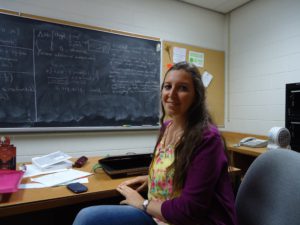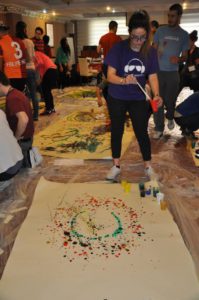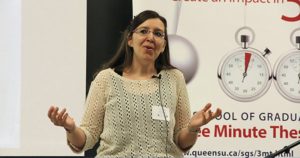Kevser Aktas and her Dream of Mathematics for All
BLOG: Heidelberg Laureate Forum

Kevser Aktas, the number theorist whose projects aim to inspire youth and ignite a facination for mathematics. We look forward to seeing her at the 4th Heidelberg Laureate Forum.
What led you to do the Mathematics for All project and the Erasmus Programme for Youth in Action?

After I completed my PhD in number theory, I decided to develop a mathematical project related with social sciences. This idea goes back to my master studies, where I worked as an elementary school teacher. It was very difficult but an amazing experience both studying hard problems in number theory as a master student and teaching elementary school algebra and geometry at the same time. I started to think about a relationship between number theory and teaching it in a more elementary way.
When the time came to finish my PhD in number theory, I decided to do something completely different that I am used to. I started to get involved in Erasmus Youth in Action Programme projects and was finally invited by the British Council to Birmingham as a representative of Turkey and had the opportunity to observe the project management of the Youth in Action Programme. Then I decided to develop my own project. There was nearly no mathematics projects related with program, which is now called the Erasmus+ Youth in Action Programme. Their aim is a cultural exchange between European countries and to give young people opportunities to network, to discuss the problems and solutions on youth unemployment and career options.
One of the most important questions is determining how the problem solving process works and approaching this process is required for daily decision making. The other side of the picture shows that we have responsibilities to our families, to the society and to each other. Why don’t we use mathematics to see the future better? Critical and analytical thinking are crucial at that moment and must be implemented. Life is full of problems for everyone and every society. The clever method is finding solutions together with analytical thinking and trying to use our creativity.
Who participated in the project?
The project Mathematics for All has grown as a European Union Project in Erasmus+. The project was held in Ankara, Turkey at Gazi University in between 8-15th March 2014 with 42 young volunteers (18-25 years) from Hungary, Italy, Latvia, Netherlands, Spain, Turkey and UK. I invited participants from different branches which were law, engineering and education students. We chose to have the project week from March 8-15 that it fell on Pi Day. Its decimal representation never ends and never settles into a permanent repeating pattern. The reason why pi makes interesting art is because the digits that appear in the decimal expansion obey no understandable order.
What are the details of the project?

The aim of Mathematics for All is to bring young people together and use mathematical methods, games and applications to develop creativity and artistic skills. It also promotes outdoor activities, sport and active lifestyle and enables cultural exchange. The project is unique example in the history of Erasmus+ using mathematical skills as natural sciences in a cultural exchange themed activity. It combines fun and learning, development of new skills and it connects several disciplines such as music, art, drama and sport with mathematics. This will also help young people improve their analytical thinking and self-expression. They see how fun mathematic is with the activities using non-formal learning methods and decrease their fear of math with activities and come together without any borders. This project aims to be an example to emphasize the connection in between formal and non-formal education.
It was a valuable experience for me to have the opportunity to work with researchers from different fields (especially from the fields like social sciences and fine arts). I worked with musicians, artists and youth leaders (who are very important for Erasmus+). We used the rhythm of sound in music and showed some relation with numbers. We used the colors and some geometry during their art activities, and they painted their own designs using geometrical patterns. We had a session on how to solve our social problems using analytic thinking process in which we gave them a real life problem to solve and we asked them for reasons and several different solutions.
Can you briefly describe the competition that you’ll attend and your inspiration for Mathematics for All?

After I had finished the project Mathematics for All I wanted to continue with my studies in number theory. I had accepted as a postdoctoral fellow at Queen’s University in Canada. Number theory is known as queen of mathematics because of its foundational place in the discipline. Then Iheard about 3 Minute Thesis (3MT), a competition where you present your research / or thesis in front of a lay audience who are not mathematicians. Three minutes is not enough to describe what a prime number is, so imagine the challenge of explaining your research in three minutes. My supervisor encouraged me to face this challenge and I planned to use the teaching methods that inform my own classes and implement some creativity from the project Mathematics for All into my presentation. I looked into the background of my research on powerful numbers and tried to find some connections with daily life to explain the importance. We generally work on conjectures, theorems and don’t know how they are being used for in application. I was able to see the big picture of my research through 3MT, and my presentation entitled “The Power of Powerful Numbers” was the first presentation on a pure mathematical research topic in number theory in the history of the competition.
Watch Kevser’s 3MT presentation.
What are your prospective plans for the project?
I would like to continue to show the connections of mathematics in life with IT (internet technologies). I also like teaching would like to improve some creative teaching methods using computer technologies especially for number theory courses. My postdoctoral supervisor, Prof. Ram Murty, introduced me to a new project called Solve MIT (Massachusetts Institute of Technology). One of the pillars of the project, Learn, has some questions related with the quality of education. One of the most important questions about education today is how do we create a culture and an environment of continuous learning? Computers have a great role to make this dream come true.
I wish that there would be more online courses, and it would be great to reach some departmental colloquiums and hear about the recent research from researchers from other continents. I would also like to design a number theory course for undergraduate level using different kinds of teaching techniques and innovative online courses.
How were you invited to an art conference in Vienna as a mathematician?
After I completed my postdoc at Queen’s University, I returned to Gazi University where my colleague worked for Mathematics for All project in the art sessions suggested that I present this research. She told me about how the International Society for Education through Art organizes a regional conference in Vienna from September 22-24, 2016. I wasn’t really sure the idea of submitting a mathematical project abstract into an arts event but recently that it was accepted and it will be an exciting challenge for me.
How did you hear about HLF?
I have heard about HLF from the manager of our Postdoctoral Training Office, Rebecca Huegler, of Department of Graduate Studies at Queen’s University. I believe that it is a wonderful idea to bring junior and senior mathematicians together from a variety of branches to talk about their experience. The workshops and other visit activities will be very inspirational for the career development of young researchers. Mathematics is known as “the mother of all sciences”, and sometimes it feels like being alone in a deep ocean.
Multi-disciplinary approach to any problem is a key function to finding a solution, to talk about new problems and to develop project ideas. Activities like Heidelberg Laureate Forum give young researchers a chance to meet with people who are experts in their own fields.
The application process for HLF was challenging and exciting for me. I am especially interesting in local visits to local/global companies and institutions. I think that it is a very good opportunity for young researchers who have not decided their career path yet. Working in academia or industry, how to find a job and being employed are very big questions in every young researcher’s mind. I wish that I could attend all of the institutions and it was very hard to choose only one of them. I am also very excited to meet with mathematicians and computer scientists from all over the world.

